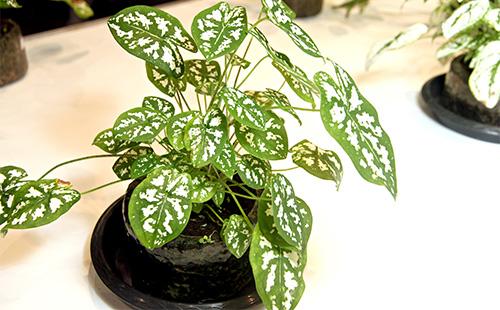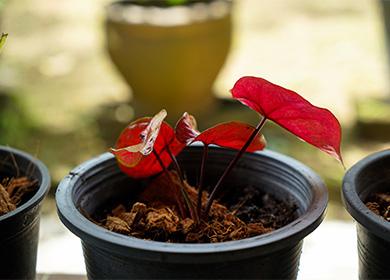The content of the article
The main feature of Caladium is that beautiful leaves last only a few months. The rest of the time he is resting. But the short period of growth is fully compensated by the incomparable beauty of the plant.
Botanical Description
Refers to herbaceous tuberous perennials. The tuber is flattened, with a rough surface, reaches a diameter of up to 10 cm. On the upper plane of the tuber there are growth points, on the lower - fibrous roots. It is distinguished by a pronounced and long period of rest. Closer to autumn, the entire aerial part of the caladium gradually dries up. Only the tuber remains to winter. Young shoots from the ground begin to hatch in the spring - usually in early March.
Leaves on long stalks grow directly from the tuber - the stem is absent. The height of the indoor bush does not exceed one meter. In nature, individual specimens reach a height of five meters. There are varieties with swept and heart-shaped leaves. The color is contrasting, the color palette is very wide.
Closer to summer, when four full leaves are formed, a cob-shaped light yellow inflorescence is formed. The ear is wrapped in a greenish bedspread. Flowering is short - no more than five days. Fruits are hard round berries. The apartments usually do not bloom.
Indoor Varieties
At least 15 species caladiums are known. Most of them are successfully adapted to the conditions of the apartment. In addition to the basic species, hybrid varieties with original colors were bred. Three types are considered the most popular.
- Humboldt. The stem is absent, the root system is tuberous. The leaves are oval, swept. Coloring motley. The main background color is dark green. It is complemented by whitish spots with a silver tint.
- Two-tone. The tubers are round, flattened, rather large. Leaves grow straight from the tuber. The shape of the leaves is spear-shaped, petioles strong, very long. Coloring motley, there are different combinations of colors - green, red, white. Depending on the variation of the species, one of the indicated colors prevails. Flowering nondescript, short.
- Schomburg. Leaves are oval elliptical. The leaves are red, silver between the veins. The underside is lighter. There are several hybrid varieties - silver vein, red, venous.
On the windowsills, it is not species caladiums that are more common, but their numerous hybrid varieties. They are more expressive, fanciful colors, better suited to the conditions of the apartment.
What to do after purchase
The procedure depends on how the plant brought from the store looks. You can buy a tuber or flower with developed leaves. The main problem for those who first encounter Caladium is the germination of tubers.
At the bottom of the dish pour a layer of clean, sterile sand. It is calcined in a pan or oven. The sand should be dry - you do not need to moisten it. The tuber is simply laid on the sand, not buried. The buds will become visible a little later, so at first it’s not so important where the tuber has the upper part and where the lower one. A plate with a tuber is placed in a well-lit warm place. Maintain a stable temperature: 22-25 ° C.
After awakening the kidneys, you can plant Caladium in the soil. The pot is taken small - twice the diameter of the tuber. A third of the volume is filled with expanded clay or other drainage material, 1-2 cm of nutrient soil are poured on top. The tuber is laid on the surface of the soil with the kidneys up. Add a little more soil - to the lower kidneys. Watering is not necessary yet.
After the appearance of roots and signs of growth, the tubers are covered with a substrate 2 cm above its surface. The first time watered gently, slightly moistening the ground. Adhere to moderate watering until leaves develop. After the appearance of foliage, you can water more.
Caladium care and microclimate parameters
How to care for caladium in a pot? Caladium is considered capricious only because of the complexity of germination of the tuber, its frequent decay. A plant with already developed leaves is not so finicky. When leaving, adhere to the following rules.
- Lighting. For a bright, contrasting color of leaves you need a diffused sunny color. It can grow in a slight shade, but fades, does not look so decorative. The optimal location is the northwest or northeast side.
- Temperature. In the summer, during the period of active growth and "wakefulness" of caladium, they maintain a stable temperature without sudden changes. Ideal indicators - 22-25 ° С. After dropping the leaves and until the next wave of vegetation, the tubers are kept at lower temperatures: 16-18 ° C.
- Watering. Caladium is recommended to be watered systematically - a day after the drying of the surface of the substrate. Large leaves evaporate a large amount of moisture - watering is plentiful. Water is used only soft and warm, just above room temperature. Some gardeners add special aquarium products to the water for irrigation. With wilting leaves, the transition of the flower during the dormant period, watering is gradually reduced, then minimized.
- Humidity. It is recommended to keep humidity at 70%. In dry air, Caladium dies. Common ways to increase humidity are by spraying air, using special humidifiers, installing the pot in a wide tray with a moist filler (pebbles, expanded clay). Leaves do not spray - brown spots appear from drops of water.
- The soil. The acidity of the soil should not exceed 6 pH. It is advisable to prepare the substrate yourself from an equal amount of peat, well-rotted humus, deciduous land and sand.
- Top dressing. Fertilizers apply a limited period of time. You can feed from the moment the leaves appear and until they wither - in the first days of August, feeding is already stopped. Use mineral complexes for deciduous decorative crops.
- Transfer. In the spring, you can transplant the caladium. Tubers are dug out of the ground, completely freed from the old substrate. The tuber is germinated to the formation of buds and planted in new soil. Caring for Caladium after transplantation is to maintain moderate humidity and a stable temperature.
Breeding methods
Caladium can be propagated by daughter nodules, division of a tuber or grown from seeds. At home, Caladium does not bloom and does not bear fruit - seeds are purchased in specialized stores.
- Subsidiary tubers. During the spring transplant, children are separated from the mother tuber, they are planted in a separate container. The scheme of germination and care is no different from working with adult tubers.
- Dividing the tuber. Mature tuber can be divided into two or three parts, planted in different pots. Cut it with a sharp sterile knife. At least one kidney is left on each part. Slices dipped in coal powder, planted in a mixture of peat and sand. They are kept in a bright, warm room at 22-24 ° C.
- The seeds. Cultivation of caladium from seeds at home is practiced to obtain plants of a new variety. At home, the seeds do not ripen. Even if you managed to collect the seeds from your plant, species characteristics are lost - in new plants, the color may turn out to be just green or completely unexpected. Seeds are sown in a mixture of sand with deciduous soil, regularly moistened, kept at high temperatures (about 30 ° C). Sprouts hatch in two to three weeks. In another month they can be planted in separate pots. Dive again in the summer. Subject to agricultural technology, small tubers are already formed by autumn.

What difficulties do flower growers face?
Caladium care is specific. The clear separation of periods of growth and wakefulness is often confusing for beginners. Errors are made during storage, germination of the tuber. A list of the most common errors and ways to fix them can be seen in the table.
Table - Errors in the cultivation of caladium
| A problem | Where is the mistake | Error correction method |
|---|---|---|
| Rotting of roots and tuber | - Watering at rest | - Extraction of the tuber from the ground, pruning of rotten areas; - processing of slices with coal powder; - landing in fresh sterile soil; - reduction of watering |
| Drying of the lower leaves | - lack of moisture | - Normalization of the irrigation regime; - increasing air humidity near the plant by spraying air from a spray gun, - humidity increase with a special device |
| Leaf edges dry | - Sunburn; - too high temperature; - excess fertilizer | - Shading from the sun; - transfer to a cool place; - temporary cessation of feeding |
| Brown spots | - Leaving traces of drops of water | - Spraying air, not the plant itself |
| Withering and falling of leaves closer to autumn | - Preparation for the rest period (natural process) | - Reduced watering |
| Lethargy, wilting in the summer | - dry air; - cold drafts | - Increase in humidity; - installation of the pot in a place inaccessible to drafts |
| Leaf curl | - Poor watering; - heat | - Regulation of watering; - moving from the sun |
| The appearance of brown spots on the edges of the leaves | - Cold air, drafts | - Transfer to a warmer room; - moving away from the draft |
Common diseases
The main diseases of caladium are associated with excessive watering. Dampness provokes the development of rot, fungal diseases. The table shows common diseases, their symptoms and treatment.
Table - Caladium Diseases
| The name and cause of the disease | External manifestations | Treatment methods |
|---|---|---|
| Bacterial rot (bacteria) | - Withering of the aerial parts of the plant; - the appearance of wet rotten spots on the tuber | - Trimming rotten areas, treating them with fungicide and coal powder; - systematic watering of caladium with systemic fungicides |
| Fusarium (fungus) | - Withering of individual leaves; - the spread of the fungus to the entire plant | - Watering and spraying with Fitosporin, Planriz preparations (usually it is not possible to save the plant) |
| Phytophthora (fungus) | - Withering, browning, drying of caladium; - browning, rotting of roots and tuber | - Cutting out all damaged parts of the tuber; - repeated, regular treatment with fungicides (there are few chances to save the plant) |
Pests and methods of dealing with them
Pests attack caladium infrequently. Sometimes you have to deal with aphids, spider mites and mealybugs. Signs of pest damage, methods of combating them are shown in the table.
Table - Caladium Pests
| Pest name | Characteristic signs | Ways to fight |
|---|---|---|
| Aphid | - Twisting new leaves; - the appearance of sticky plaque; - yellowing of leaves | - washing the bush with soapy water; - treatment with a drug containing permethrin |
| Mealybug | - The formation of a whitish, waxy coating on the petioles and the base of the leaves; - the appearance of lumps similar to cotton wool; - lethargy of a flower | - Spraying with mineral oil (washing off after an hour); - treatment with any systemic insecticide |
| Spider mite | - The appearance of light yellowish dots on the leaves; - yellowing of the leaves; - thin web formation | - Increase in humidity; - spraying with the drug "Aktara" |
Knowing how to care for Caladium, given its natural life cycles, it is possible to achieve high decorative leaves and splendor of the bush. The main requirement for growing caladium is to create the most favorable conditions during winter dormancy.

